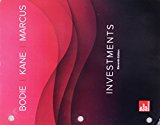
a.
To compute: The Sharpe ratios for the Miranda fund and the S&P 500.
Introduction:
Sharpe ratio: It is one of risk measurement ratios. When a performance of an investment has to be done and that too in comparison with a risk-free asset, Sharpe ratio is utilized.
a.
Answer to Problem 21PS
The Sharpe ratio for Mirinda Fund is 0.2216 and S&P 500 is -0.5568.
Explanation of Solution
Given information:
Risk-free interest rate=2%
| One- year Trailing Returns | ||
| Miranda Fund | S&P 500 | |
| Return | 10.20% | -22.50% |
| Standard deviation | 37.00% | 44.00% |
| Beta | 1.10 | 1.00 |
Let us calculate the Sharpe ratio using the formula:
Let us now substitute the given values in the formula.
| Mirinda Fund | S&P 500 | |
| Sharpe Ratio |
Therefore, the Sharpe ratio for Mirinda Fund is 0.2216 and S&P 500 is -0.5568.
b.
To compute: The M2 measures for Miranda and S&P 500.
Introduction:
M2 measure: It is also termed as M-square measure. It is used to calculate the return which has to be adjusted for the risk associated with a portfolio along with benchmark.
b.
Answer to Problem 21PS
The M2 of Mirinda Fund (portfolio P) would be 34.25%.
Explanation of Solution
Giveninformation:
Risk-free interest rate=2%
| One- year Trailing Returns | ||
| Miranda Fund | S&P 500 | |
| Return | 10.20% | -22.50% |
| Standard deviation | 37.00% | 44.00% |
| Beta | 1.10 | 1.00 |
The formula to calculate the M2is as follows:-
Where,
One point to be kept in mind is that to get the position of volatility which is similar to the market, the funds have to be combined with the T-Bills.
Let us now calculate the adjusted portfolio.
Now, we have to calculate the position in T-Bills:
Therefore, when we check for the weight of Mirinda fund in adjusted portfolio, it will be 1.1892 and when amount is borrowed at a rate which is equal to 0.1892 will result in risk-free rate.
Therefore, the end result would be as follows:
Volatility of return of portfolio=Volatility in return on market index.
Now, let us calculate the M2of Mirinda Fund:
This value has to be converted into percentage by multiplying it with 100.
Therefore, the M2 of Mirinda Fund (portfolio P) would be 34.25%
c.
To compute: The Treynor’s measure ratios for the Miranda fund and the S&P 500.
Introduction:
Treynor’s ratio: It is also termed as Treynor’s measure in some instances. It is one of the measures used to calculate the risk adjusted return. It calculates the returns on the basis of systematic risk which differentiates this ratio with other related ratios.
c.
Answer to Problem 21PS
The Sharpe ratio for Mirinda Fund is 7.45% and S&P 500 is -24.50%.
Explanation of Solution
Given information:
Risk-free interest rate=2%
| One- year Trailing Returns | ||
| Miranda Fund | S&P 500 | |
| Return | 10.20% | -22.50% |
| Standard deviation | 37.00% | 44.00% |
| Beta | 1.10 | 1.00 |
The formula to be used to calculate the Treynor’s measure is as follows:
Where
RP=Return on portfolio
RF= Risk free
ß = Systematic risk
| Mirinda Fund | S&P 500 | |
| Treynor’s measure |
Therefore, the Sharpe ratio for Mirinda Fund is 7.45% and S&P 500 is -24.50%.
d.
To compute: The Jenson measure for the Miranda Fund.
Introduction:
Jenson Measure: This measure is used to calculate the average rate of return. The return calculated is on the investment made in a portfolio.
d.
Answer to Problem 21PS
The Jenson measure of Mirinda fund is 35.15%.
Explanation of Solution
Given information:
Risk-free interest rate=2%
| One- year Trailing Returns | ||
| Miranda Fund | S&P 500 | |
| Return | 10.20% | -22.50% |
| Standard deviation | 37.00% | 44.00% |
| Beta | 1.10 | 1.00 |
The formula is as follows:
Therefore, the Jenson measure of Mirinda fund is 35.15%.
Want to see more full solutions like this?
Chapter 24 Solutions
GEN COMBO LOOSELEAF INVESTMENTS; CONNECT ACCESS CARD
- solve this question.Pat and Chris have identical interest-bearing bank accounts that pay them $15 interest per year. Pat leaves the $15 in the account each year, while Chris takes the $15 home to a jar and never spends any of it. After five years, who has more money?arrow_forwardWhat is corporate finance? explain all thingsarrow_forwardSolve this finance problem.arrow_forward
 Essentials Of InvestmentsFinanceISBN:9781260013924Author:Bodie, Zvi, Kane, Alex, MARCUS, Alan J.Publisher:Mcgraw-hill Education,
Essentials Of InvestmentsFinanceISBN:9781260013924Author:Bodie, Zvi, Kane, Alex, MARCUS, Alan J.Publisher:Mcgraw-hill Education,

 Foundations Of FinanceFinanceISBN:9780134897264Author:KEOWN, Arthur J., Martin, John D., PETTY, J. WilliamPublisher:Pearson,
Foundations Of FinanceFinanceISBN:9780134897264Author:KEOWN, Arthur J., Martin, John D., PETTY, J. WilliamPublisher:Pearson, Fundamentals of Financial Management (MindTap Cou...FinanceISBN:9781337395250Author:Eugene F. Brigham, Joel F. HoustonPublisher:Cengage Learning
Fundamentals of Financial Management (MindTap Cou...FinanceISBN:9781337395250Author:Eugene F. Brigham, Joel F. HoustonPublisher:Cengage Learning Corporate Finance (The Mcgraw-hill/Irwin Series i...FinanceISBN:9780077861759Author:Stephen A. Ross Franco Modigliani Professor of Financial Economics Professor, Randolph W Westerfield Robert R. Dockson Deans Chair in Bus. Admin., Jeffrey Jaffe, Bradford D Jordan ProfessorPublisher:McGraw-Hill Education
Corporate Finance (The Mcgraw-hill/Irwin Series i...FinanceISBN:9780077861759Author:Stephen A. Ross Franco Modigliani Professor of Financial Economics Professor, Randolph W Westerfield Robert R. Dockson Deans Chair in Bus. Admin., Jeffrey Jaffe, Bradford D Jordan ProfessorPublisher:McGraw-Hill Education





